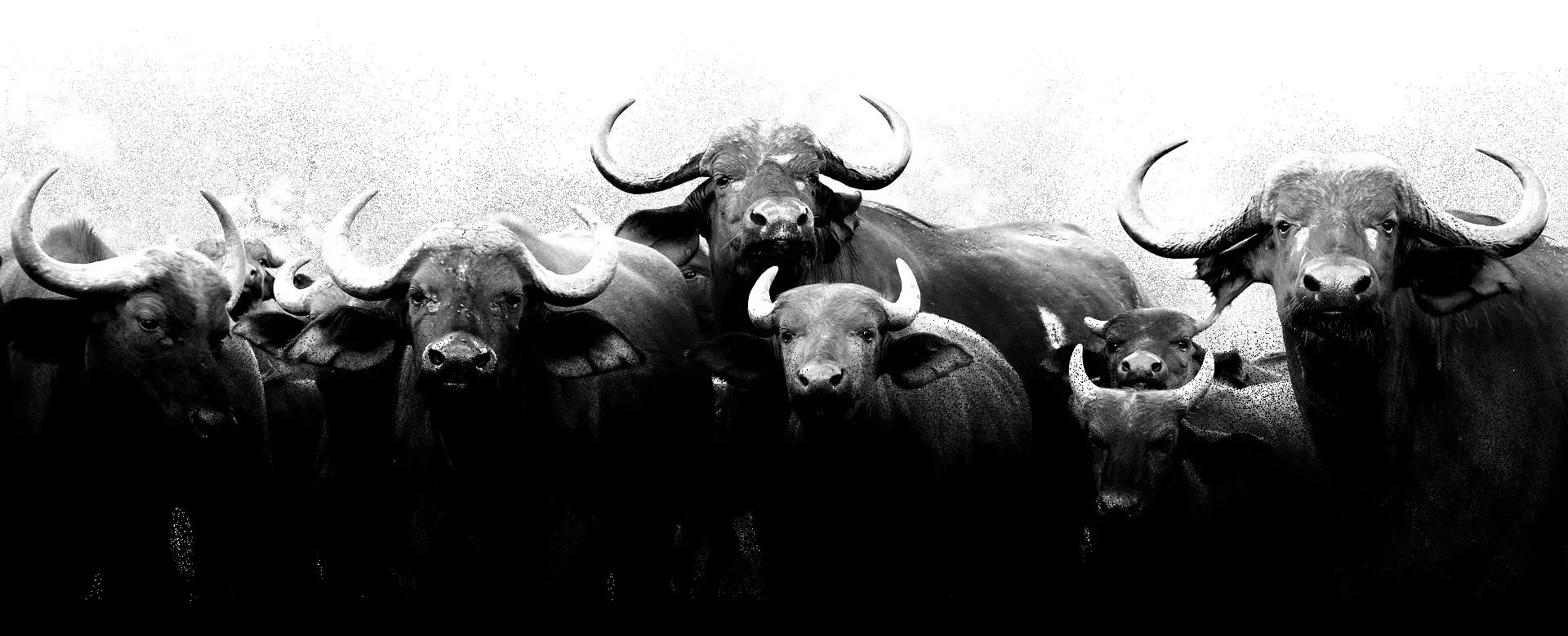
(Mephitidae)
Skunks and Stink-Badgers
Скунсові
The family Mephitidae, which includes the skunks and stink badgers, is comprised of four extant genera (Mephitis, Conepatus, Spilogale and Mydaus) and 13 species. Three of the four genera of skunks inhabit the New World, collectively ranging from Canada to central South America; the exception are stink badgers (Mydaus), which occur on islands in Indonesia and the Philippines.
Habitat
Members of the family Mephitidae can be found in a variety of habitats, including relatively open forests, grasslands, agricultural areas, meadows, open fields, and rocky montane areas. Stink badgers may even spend some of their time in caves. Mephitids generally do not occur in very dense forests or in wetlands. During the day, skunks and stink badgers seek shelter in burrows or under the cover of rocks or logs. They can dig the burrows themselves, or may use the dens of other species, such as marmots or badgers. At night, skunks and stink badgers come out from their dens and forage. Some skunks are agile climbers (e.g., Spilogale) and can be found in trees in search of food or to avoid predators.
Physical Description
Skunks and stink badgers can be recognized by their striking color patters. They are generally black (or sometimes brown) with a prominent, contrasting pattern of white fur on their faces, backs, and/or their tails. Generally, they have either white spots, or a white stripe running from their head, down their back to their tail. Patterns vary within and among species. For example, spotted skunks, as the name implies, have many white spots on a black background. Striped skunks have white dorsal stripes of varying thickness and length that may or may not run through the tail or extend onto the head. Coloration in skunks and stink badgers serves as an aposematic signal to would-be predators. All mephitids have extremely well-developed anal scent glands with which they produce noxious odors to deter threats. The product of the scent glands is secreted through nipples near the anus, and can be projected between 1 and 6 meters towards a threatening animal.
Mephitids have a relatively long rostrum (although it is not so large in Spilogale), broad, squat bodies, and often a thickly-furred tail. They have short limbs and robust claws that are well-suited for digging. Spotted skunks (Spilogale) are the smallest members of this family, weighing between 200 g and 1 kg. Hog-nosed skunks (Conepatus) reach the largest sizes (up to 4.5 kg).
Reproduction
Generally, skunks are not territorial, and individuals of many species regularly den with conspecifics. During the mating season, males of some species may monopolize several females (e.g. Mephitis mephitis), chasing other males away when they approach. Even when males do not actively defend a group of females, male home ranges often overlap with those of females indicating that individual males may mate with several females in a season.
Little is known about the breeding biology of stink badgers.
Skunks are seasonal breeders; typically, the breeding season lasts two to three months, but the time of the breeding season varies among species, and within species according to geographic location.
Skunks’ gestation period varies among species. In Mephitis and Conepatus, gestation lasts 2 to 3 months. Spilogale gracilis undergoes delayed implantation, in which the fertilized egg does not implant into the uterine wall for a prolonged period of time. Spilogale putorius also exhibits delayed implantation, but only in the northern part of its range. Gestation times (including delayed implantation) in these species can last 250 days or more. Delayed implantation is more typical of species and or populations that live in seasonal climates.
Skunks generally give birth to 2-10 altricial young per year in a single litter. The young are weaned after about two months and become sexually mature late in their first year of life.
Little is known about parental care in stink badgers. Being mammals, females must invest some care before the young are weaned.
Skunks are born in an altricial state, without fur and with their eyes closed. Although the stink glands are full at birth, young cannot use them in defense until after the first week of life, and thus rely on the mother for full protection from predators. The young are weaned after about two months and can begin foraging on their own. Young will share a den with their mothers, and perhaps other conspecifics. Den sharing is especially important during the winter in northern areas to increase survival.
Lifespan/Longevity
First-year skunks suffer high mortality (~ 50% – 70%) as a result of predation and disease. Those that survive can live up to 7 years in the wild, although 5 to 6 years is more typical, and up to 10 years in captivity.
Behavior
Members of the family Mephitidae are perhaps most familiar to people because of their conspicuous antipredator behavior. All mephitids can project a sticky, foul-smelling secretion from their anal scent glands in order to deter a potential threat. Stink badgers can spray over one meter, whereas some skunks (e.g. Mephitis mephitis) can spray an attacker at distances over 6 meters. When confronted with a presumed threat, skunks first face the threat, raise their tails with hair standing on end, and might also stomp on the ground. Skunks may even stand on their forepaws in a “handstand” as they face their attacker. If sufficiently provoked, they will bend their bodies in a U-shape, aiming their hindquarters at the threat and spraying fluid. Typically, skunks aim for a predator’s eyes, which are especially sensitive to the fluid. In addition to spraying attackers, some skunks (e.g., Spilogale putorius) climb trees to avoid danger.
Skunks and stink badgers are nocturnal. They spend the daytime hours in burrows or hollow logs, and forage in the evenings for vegetation, insects, worms, and small vertebrates. In seasonal climates, skunks remain in their dens during the winter months. While they do not enter deep hibernation, they do subsist mainly on fat reserves. Communal dens help skunks conserve energy in the winter.
Skunks are not typically aggressive towards each other, or to heterospecifics. Home ranges typically overlap, and males of some species only actively defend females during the mating season. Although skunks generally forage alone, they may den in groups of several individuals, or even with other species. In many cases, adult males den by themselves or only with females.
Communication and Perception
Skunks are generally not vocal, but sometimes communicate with grunts, growls, and hisses. Olfaction is probably an important part of communication, especially during the mating season. Skunks are not territorial, so do not need to mark territories. Skunks have elaborate visual displays to ward off potential predators, which include holding the tail and body erect, standing on the forepaws, and stomping the ground.
Food Habits
Members of the family Mephitidae are omnivorous, but a large proportion of their diet consists of animal material. Skunks and stink badgers eat a variety of invertebrates such as worms and insects. They also eat small vertebrates such as rodents, lizards, snakes, birds and eggs. Mephitids forage nocturnally, rooting for and digging up prey as they wander through their home range. In northern areas, skunks greatly increase their fat reserves during the fall. During the winter months these skunks spend most of their time sleeping in dens, but will emerge to forage on warmer days.
Predation
Although their scent gland secretions are a potent deterrent to predators, mephitids are at risk of predation. This is especially true for young skunks. When they are out of their burrows, skunks remain relatively conspicuous and depend on their warning coloration to deter attackers. Known predators of skunks and stink badgers are larger carnivores such as coyotes, foxes, pumas, civets, American badgers, and lynx. Birds of prey, having less well-developed olfaction than mammals, are less susceptible to the skunks’ odor, although being sprayed in the eyes is a risk. Avian predators may include eagles and owls. Great horned owls (Bubo virginianus) are known to prey on skunks.

(Conepatus chinga)
Molina's Hog-nosed Skunk
Свинорилий скунс Моліни
Its native range is throughout mid to southern South America, Chile, Peru, Argentina, Bolivia, Paraguay, Uruguay, and southern Brazil. It inhabits the Pampas biome and prefers open vegetation, shrub forests, and rocky slopes at elevations of up to 5,000 m.

(Conepatus humboldtii)
Humboldt's Hog-nosed Skunk
Свинорилий скунс Гумболдта
It inhabits open grassy areas in the Patagonian regions of southern Argentina and Chile.
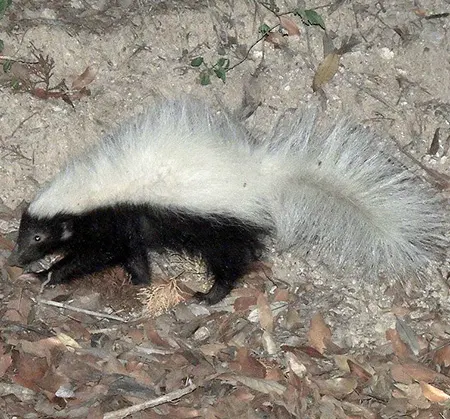
(Conepatus leuconotus)
American Hog-nosed Skunk
Американський свинорилий скунс
It is found in El Salvador, Guatemala, Honduras, Mexico, Nicaragua, and the United States, inhabiting a wide range of habitats including forests, grasslands, deserts, rugged terrain, and rocky canyons in mountainous regions.
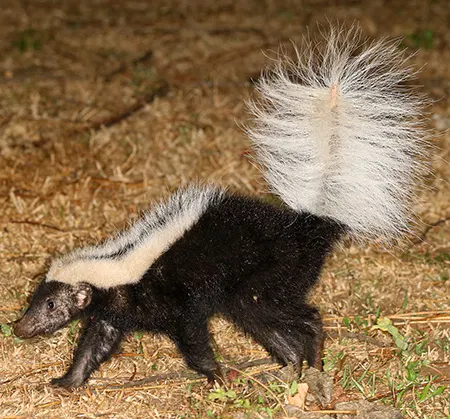
(Conepatus semistriatus)
Striped Hog-nosed Skunk
Смугастий свинорилий скунс
It is found in Central and South America, ranging from southern Mexico to northern Peru, and in the far eastern regions of Brazil. It inhabits carrasco, arboreal caatinga, mango orchards, dry forest scrub, and occasionally, rainforest.
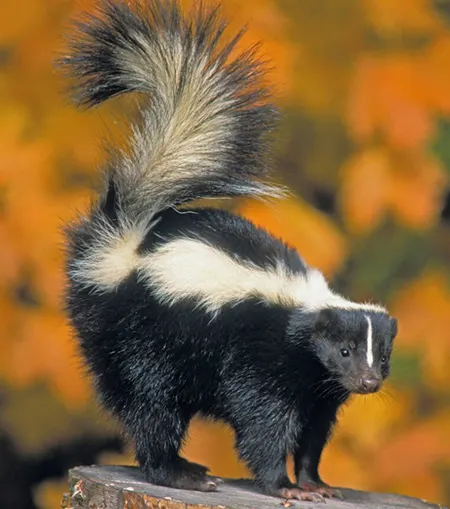
(Mephitis mephitis)
Striped Skunk
Скунс смугастий
It occurs across much of North America, including southern Canada, the United States, and northern Mexico. It inhabits forests, plains, and deserts, with a preference for open or wooded areas at elevations of up to 1,800 m.

(Mephitis macroura)
Hooded Skunk
Скунс довгохвостий
It is found from the south-western United States through Mexico, Guatemala, Honduras, and Nicaragua, to north-western Costa Rica. It inhabits grasslands, deserts, and the foothills of mountains at elevations of up to 2,440 m.
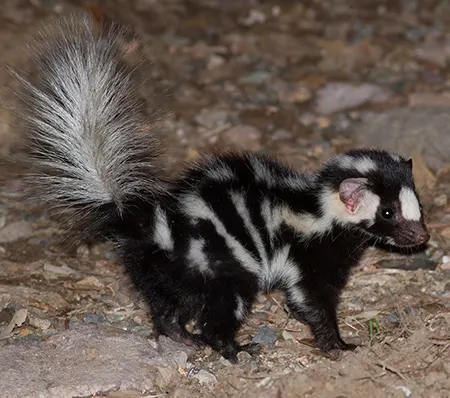
(Spilogale gracilis)
Western Spotted Skunk
Плямистий скунс західний
It is found throughout the western United States, northern Mexico, and southwestern British Columbia in Canada. Its habitat is mixed woodlands, open areas, and farmlands.
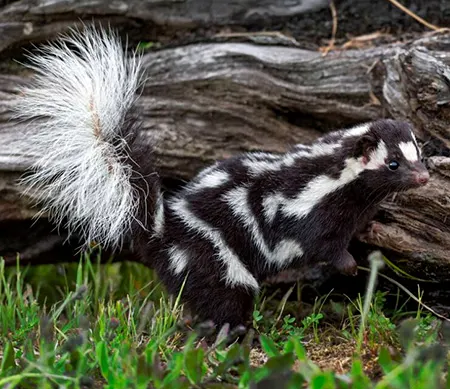
(Spilogale putorius)
Eastern Spotted Skunk
Плямистий скунс східний
It is found in Canada (south-eastern Manitoba and north-western Ontario), the United States, and north-eastern Mexico. It prefers forest edges and upland prairie grasslands.

(Spilogale pygmaea)
Pygmy Spotted Skunk
Плямистий скунс карликовий
It inhabits the Pacific coast of Mexico, where it is found in woodlands and thickets with rocky soil, avoiding dense forests and swamps.
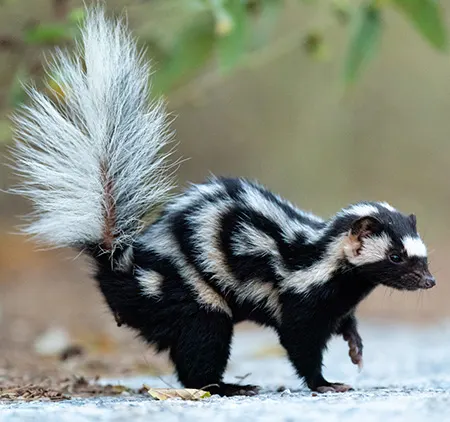
(Spilogale angustifrons)
Southern Spotted Skunk
Плямистий скунс південний
It is native to Central America, ranging from Costa Rica to southern Mexico. It occurs at elevations up to 300 m in dry, rocky areas with scrub and open woodland, and also in agricultural areas.

(Spilogale interrupta)
Plains Spotted Skunk
Плямистий скунс рівнинний
It is found in the United States, ranging from the Great Plains eastward to the Mississippi River. It inhabits prairies, pasturelands, non-submerged grasslands, forest edges, woodlands, and agricultural areas.
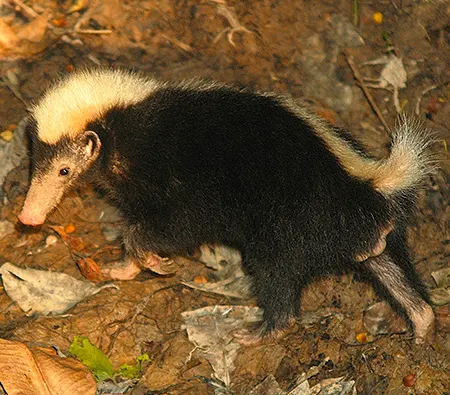
(Mydaus javanensis)
Sunda Stink Badger
Смердючий борсук яванський
It is found in Java, Sumatra, Borneo, and the northern Natuna Islands. It inhabits forest edges and areas of secondary forest.

(Mydaus marchei)
Palawan Stink Badger
Смердючий борсук палаванський
It is found on the Philippine island of Palawan, and also on the neighbouring islands of Busuanga and Calauit. It primarily inhabits grasslands and cultivated areas.
